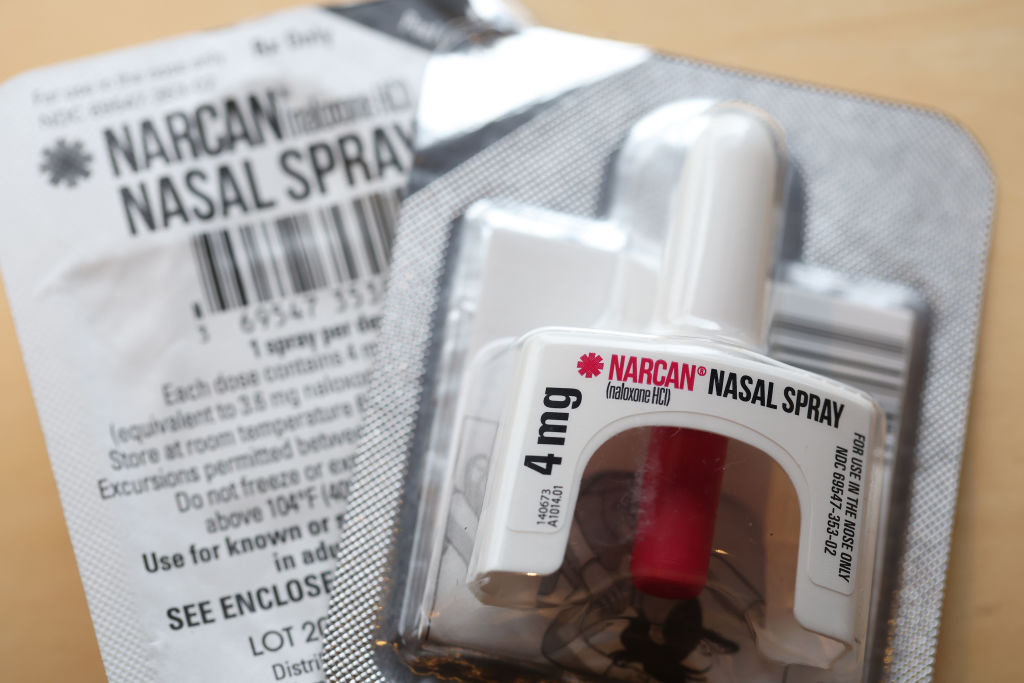
The opioid overdose epidemic, which caused 80,000 deaths in 2021, can often seem like an unrelenting tragedy, but on Wednesday, there was cause to celebrate. The U.S. Food and Drug Administration announced that it has approved Narcan, a nasal-spray form of the opioid-overdose-reversing drug naloxone, without a prescription over-the-counter. This is a major win, because Narcan works as first aid, and must typically be administered by someone else to an overdosing person. Over-the-counter Narcan could mean that more people have the medicine on hand during the crucial minutes of an overdose.
At the same time, public health experts say that efforts to improve naloxone access cannot stop with over-the-counter access when it becomes available—which manufacturer Emergent BioSolutions projects will be in late summer. Going forward, they warn, two obstacles which have prevented people from buying Narcan in the past could remain barriers going forward: high cost and stigma against drug users.
While Emergent BioSolutions has not yet commented on the price of over-the-counter Narcan, there’s reason to be wary that the drug could be costly: prescription Narcan can cost over $100 for two doses at some pharmacies, according to GoodRx. Chelsea Shover, an epidemiologist and assistant professor at the University of California-Los Angeles notes that many of the people she’s provided Narcan to for free—including teenagers and people living in street encampments—wouldn’t be able to afford it on their own. Also uncertain is whether insurance companies, which have historically covered most of the cost of Narcan, will cover an over-the-counter drug.
“Narcan was covered by many kinds of insurance at no or very low cost to the consumer. Now that it’s available over the counter, I worry about losing that coverage,” says Shover.
The other challenge, says Lucas Hill, a clinical associate professor at the University of Texas at Austin College of Pharmacy, is that there’s persistent stigma about needing Narcan. This stigma, he says, can impact every step of buying the medicine, including making opioid prescribers or pharmacists hesitant to recommend that a patient buy Narcan, in the worry that they might offend patients by the suggestion. In particular, he says, he fears that high cost of Narcan and prejudice against drug users will converge and lead many grocery stores and pharmacies to lock it up or keep it behind the counter, which would require customers to request it.
“Even though the [over-the-counter] transition could theoretically allow Narcan nasal spray to be sold at a gas station, I think it’s unlikely that we’re going to see it next to the Pringles chips anytime soon,” he says.
But overall, Hill says that he’s optimistic that over-the-counter Narcan will greatly improve access. Even if the drug remains costly, it is still expected to be less expensive for people without insurance than the prescription version. Indeed, in Hill’s view, the FDA should make all forms of naloxone, including the injectable dose, available over the counter, because that could potentially lower the cost of the drug overall as manufacturers are forced to compete on price.
Until that day, the other formulations of naloxone will still be prescription only—which means that people with insurance will still be able to obtain those other formulations through their coverage.
Meanwhile, people without insurance and who cannot afford the over-the-counter drug will still likely be available to obtain it through other avenues. Naloxone is often available through non-profits and community organizations for free, in part because they can purchase Narcan at a discounted rate, or by distributing less-costly injectable forms of the medicine. Emergent BioSolutions told TIME that it plans to continue the program to discount Narcan for public interest customers.
Going forward, experts say that health care workers will play a vital role in reducing stigma about naloxone and opioid use disorder. Dr. Michael W. Champeau, president of the American Society of Anesthesiologists, says that doctors should routinely spread the word about naloxone, especially if a patient has a prescription for opioids. “I think that incorporating questions about the presence and availability of narcotics in the home, stressing the importance of having naloxone available, are going to be increasingly perceived as part of being a good physician, no matter what specialty you practice,” says Champeau.
Hill hopes the recognition that some people overdose when they don’t even know they’re using an opioid will help to reduce stigma about carrying Narcan, especially as people realize they could help save someone else. “Decreasing the stigma associated with illegal drug use and drug poisonings is the long haul. And we’ve got quite a ways to go,” says Hill.
More Must-Reads from TIME
- Cybersecurity Experts Are Sounding the Alarm on DOGE
- Meet the 2025 Women of the Year
- The Harsh Truth About Disability Inclusion
- Why Do More Young Adults Have Cancer?
- Colman Domingo Leads With Radical Love
- How to Get Better at Doing Things Alone
- Michelle Zauner Stares Down the Darkness
Contact us at letters@time.com